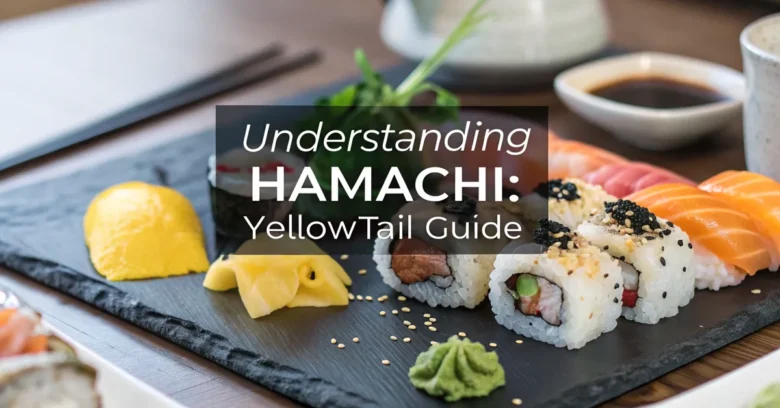Craving sushi but unsure about what to order? Maybe you’ve seen “hamachi” on the menu and wondered what it is. You’re not alone! Many home cooks and sushi lovers find themselves curious about this popular fish. The good news is that understanding hamachi, often called yellowtail fish, is easier than you might think.
This guide will provide everything you need to know about yellowtail fish, from its taste and texture to how to select the best cuts for your next meal. Forget those confusing sushi menus, and get ready to confidently choose this delicious fish at the restaurant or the market.
What Is Yellowtail Fish?
Yellowtail fish, known in Japanese as hamachi (ハマチ) or buri (鰤), refers to several species of fish in the Seriola genus. While multiple varieties exist, the one most commonly found in sushi restaurants and fish markets is Seriola quinqueradiata, often called Japanese amberjack. This fish is prized for its rich, buttery flavor and smooth texture, making it a favorite among sushi enthusiasts.
Outside of sushi, yellowtail fish can be pan-seared, grilled, or roasted. The firm, rich flesh holds up well to cooking and can be prepared in many ways.
Hamachi vs. Buri: What’s the Difference?
While both terms refer to yellowtail fish, hamachi and buri indicate different stages of the fish’s life cycle and, consequently, its fat content and flavor.
-
Hamachi (ハマチ): Refers to younger yellowtail, typically around one to two years old and weighing less than 5 kg (11 lbs). These fish are farm-raised and have a milder, more delicate flavor with a slightly leaner profile.
-
Buri (鰤): Denotes mature, wild-caught yellowtail that are typically three to five years old and weigh over 5 kg. Buri boasts a richer, more intense flavor and a higher fat content, particularly during the winter months when they build up fat reserves to survive the cold.
Some may consider buri the superior fish as the meat is high in fat, but both types of yellowtail offer a unique culinary experience.
What Does Yellowtail Fish Taste Like?
Yellowtail fish offers a distinct taste profile. Hamachi has a mild, buttery, and slightly sweet flavor, making it accessible to those new to seafood. The texture is smooth and firm, almost melting in your mouth. Buri, on the other hand, presents a richer, more intense flavor due to its higher fat content. It has a pronounced umami taste with a melt-in-your-mouth feel.
The taste can also vary based on the cut of the fish. For example, the kama (collar) is the fattiest and most flavorful part, while the back loin is leaner and milder.
Nutritional Benefits of Yellowtail Fish
Beyond its delicious taste, yellowtail fish offers several nutritional benefits:
- Omega-3 Fatty Acids: Rich in omega-3 fatty acids, including EPA (eicosapentaenoic acid) and DHA (docosahexaenoic acid), which are essential for heart health, brain function, and reducing inflammation. A 3-ounce (85-gram) serving of yellowtail can provide a significant portion of your daily omega-3 requirements.
- Protein: A good source of high-quality protein, crucial for building and repairing tissues, supporting immune function, and promoting overall health.
- Vitamins and Minerals: Contains essential vitamins and minerals, including vitamin B12, selenium, and niacin. Vitamin B12 is vital for nerve function and red blood cell formation, while selenium acts as an antioxidant, protecting cells from damage.
- Lean Protein Source: Yellowtail is relatively low in calories and saturated fat, making it a healthy choice for those looking to manage their weight or improve their overall diet.
According to the USDA, a 3-ounce serving of raw yellowtail tuna (hamachi) contains:
- Calories: 131
- Protein: 19.7 grams
- Fat: 4.9 grams
- Saturated Fat: 1.2 grams
- Cholesterol: 42 milligrams
- Sodium: 54 milligrams
- Omega-3 Fatty Acids: Approximately 1 gram
Popular Cuts of Yellowtail Fish
When purchasing yellowtail fish, understanding the different cuts will help you choose the best option for your desired preparation.
- Saku: This is a rectangular block of yellowtail loin, skinless and boneless. It’s a versatile cut perfect for sushi, sashimi, or searing. The saku block is easy to slice and portion, making it a great choice for home cooks.
- Loin: Yellowtail loin comes from the back of the fish and is divided into two main parts:
- akami: The leanest part of the loin, offering a clean, mild flavor. Ideal for those who prefer less fatty fish.
- toro: Located closer to the belly, toro is the fattiest and most prized part of the loin. It has a rich, buttery flavor and a melt-in-your-mouth texture, making it a delicacy for sushi and sashimi.
- Belly (Hara): The belly, or hara, is the fattiest part of the yellowtail, offering an intense, rich flavor and a smooth, almost creamy texture. This cut is highly sought after for sushi and sashimi.
- Collar (Kama): The collar, or kama, is the area behind the head and above the pectoral fin. It is considered a delicacy due to its high fat content and rich flavor. It’s often grilled or broiled.
- Cheek (Hoo): The cheek meat, or hoo, is a small, flavorful cut located in the head of the fish. While not as common as other cuts, it is tender and sweet. It is often grilled or pan-fried.
How to Select the Freshest Yellowtail
Choosing fresh, high-quality yellowtail fish is crucial for taste and safety. Here’s what to look for:
- Appearance: The flesh should have a vibrant color. Depending on the cut, it can range from a pale pink to a deeper reddish-pink. Avoid fish with a dull, faded, or brownish color, as this indicates it is not fresh.
- Smell: Fresh yellowtail should have a mild, sea-like scent. If it smells overly fishy or ammonia-like, it is best to avoid it.
- Texture: The flesh should be firm and elastic, springing back when lightly pressed. Avoid fish that feels soft, mushy, or slimy.
- Moisture: The surface of the fish should appear moist but not excessively wet or slimy.
- Source: Inquire about the source of the fish. Opt for reputable suppliers who follow proper handling and storage practices. If possible, choose fish that has been sustainably harvested or farm-raised.
- Eyes (if purchasing a whole fish): The eyes should be clear, bright, and slightly bulging. Sunken or cloudy eyes indicate that the fish is not fresh.
- Skin (if present): The skin should be shiny and have a metallic sheen. The scales should be tightly adhered to the skin.
- Ask Your Fishmonger: Don’t hesitate to ask your fishmonger for advice. They can provide valuable insights into the freshness and quality of the fish.
- Check the Date: If purchasing pre-packaged yellowtail, check the “sell-by” or “use-by” date to ensure freshness.
Potential Risks of Consuming Yellowtail Fish
While yellowtail fish is a healthy and delicious option, it’s essential to be aware of potential risks associated with consuming it.
- Parasites: Raw fish, including yellowtail, can potentially contain parasites. To minimize this risk, purchase fish from reputable sources that follow proper handling and freezing practices. Freezing fish at -4°F (-20°C) for at least seven days kills parasites.
- Scombroid Poisoning: Scombroid poisoning, also known as histamine poisoning, can occur when fish is not properly stored and handled. Bacteria can produce histamine, which causes symptoms such as rash, nausea, vomiting, diarrhea, and headache. To prevent scombroid poisoning, ensure that yellowtail is kept refrigerated at or below 40°F (4°C) and consumed promptly.
- Mercury: Yellowtail, like other fish, can contain mercury, a toxic heavy metal. Larger, predatory fish tend to have higher mercury levels. Pregnant women, nursing mothers, and young children should limit their consumption of fish high in mercury. According to the FDA, yellowtail is a “good choice” and can be eaten two to three servings a week.
- Allergies: Fish allergies are relatively common. Symptoms can range from mild (hives, itching) to severe (anaphylaxis). If you are allergic to fish, avoid consuming yellowtail.
- Farmed vs. Wild-Caught: Farmed yellowtail may have different nutritional profiles and environmental impacts compared to wild-caught fish. Farmed fish may have higher fat content and may be raised with antibiotics or other chemicals. Choose sustainably raised or wild-caught options whenever possible.
Simple Ways to Prepare Yellowtail Fish at Home
Now that you know how to select the best yellowtail, here are some simple ways to prepare it at home.
Sashimi
- Ingredients:
- Fresh yellowtail saku block
- Soy sauce
- Wasabi
- Pickled ginger
- Instructions:
- Use a sharp knife to slice the yellowtail into thin, even pieces.
- Arrange the slices on a plate.
- Serve with soy sauce, wasabi, and pickled ginger.
Yellowtail Sushi
- Ingredients:
- Cooked sushi rice
- Fresh yellowtail saku block
- Wasabi
- Nori seaweed (optional)
- Instructions:
- Form the sushi rice into small oblong shapes.
- Place a small dab of wasabi on top of each rice ball.
- Slice the yellowtail into thin pieces and place them on top of the wasabi.
- Optionally, wrap a thin strip of nori seaweed around the sushi.
Seared Yellowtail
- Ingredients:
- Yellowtail loin
- Sesame oil
- Soy sauce
- Rice vinegar
- Ginger, minced
- Scallions, thinly sliced
- Instructions:
- Pat the yellowtail loin dry and season with salt and pepper.
- Heat sesame oil in a skillet over high heat.
- Sear the yellowtail for 30-60 seconds per side, until lightly browned on the outside but still rare in the center.
- Slice the yellowtail thinly and arrange on a plate.
- In a small bowl, whisk together soy sauce, rice vinegar, minced ginger, and scallions.
- Drizzle the sauce over the seared yellowtail.
Grilled Yellowtail Collar (Kama)
- Ingredients:
- Yellowtail collar (kama)
- Salt
- Lemon wedges
- Instructions:
- Preheat your grill to medium-high heat.
- Rinse the yellowtail collar and pat it dry.
- Season generously with salt.
- Grill the collar for 5-7 minutes per side, until cooked through and slightly charred.
- Serve immediately with lemon wedges.
Is Yellowtail Sustainable? Understanding the Environmental Impact
When selecting yellowtail, it’s important to consider its sustainability. Both farmed and wild-caught yellowtail can have environmental impacts, and choosing responsibly sourced options is key.
- Farmed Yellowtail:
- Pros: Farmed yellowtail can relieve pressure on wild populations and provide a consistent supply of fish.
- Cons: Farming practices can lead to habitat destruction, pollution from fish waste and chemicals, and the spread of diseases to wild populations.
- What to Look For: Look for certifications such as Best Aquaculture Practices (BAP) or Aquaculture Stewardship Council (ASC), which indicate that the fish was raised using environmentally responsible methods.
- Wild-Caught Yellowtail:
- Pros: Wild-caught yellowtail can be a more natural and sustainable option if harvested responsibly.
- Cons: Overfishing can deplete wild populations, and certain fishing methods can damage marine habitats and result in bycatch (the unintentional capture of other marine species).
- What to Look For: Check for certifications such as the Marine Stewardship Council (MSC), which indicates that the fish was harvested from a sustainable fishery. You can also consult resources like the Monterey Bay Aquarium Seafood Watch to learn about the sustainability of different fisheries.
Should You Get Yellowtail Fish?
Whether yellowtail fish is a good choice comes down to personal preference, availability, and how you plan to prepare it. If you enjoy rich, buttery fish and are looking for a versatile option for sushi, sashimi, or grilling, yellowtail is an excellent choice. By understanding the different cuts, selecting fresh, high-quality fish, and considering its sustainability, you can confidently enjoy yellowtail in your culinary adventures.



